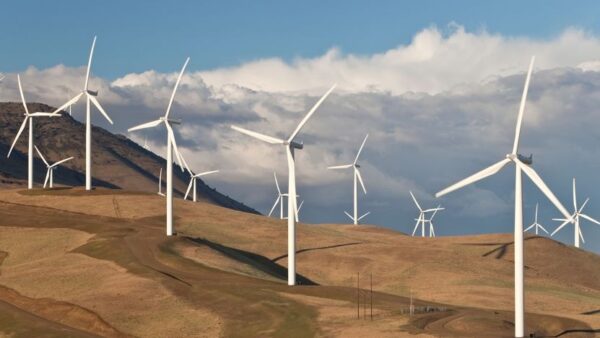The Wind is Air in Motion. It is caused by differential heating of land, water, hills and mountain slopes by sun rays. About 25 % (i.e., 0.34 KW/m2) of incident solar radiation is dissipated as wind energy. There is kinetic energy in wind. That energy has been in direct use in sailing ships since very ancient times. Columbus and Vasco da Gama — the great sailors utilized kinetic energy of the wind in sailing their ships around the globe. Land surface transport was not developed in those days. Now, California with 1 7,000 turbines, generating 1,500 MW, is the world’s largest producer of wind energy.
Method of Harnessing the Wind Energy
The wind energy is commonly used in operating wind mills that grind the grain,
and drive water pumps for irrigation. A wind mill is a machine that converts. Wind energy into mechanical energy. The mechanical energy is applied to run wind turbines which convert mechanical energy into electrical energy. The area in which planted, is called as a Wind Farm. Potential of Wind Power Generation in India
The gross wind power potential of India as per the reports of Government of India-2007, is estimated to be about 45,000 MW but its current technical potential is about 14,775 MW only. After, addition of a capacity of 5,340 MW up to March 2006 placed India on the fifth place in the world after Germany, USA, Denmark and Spain.
During the year 1999—2000, wind turbine equipments worth Rs. 50 crores were exported from India. Now, world’s largest Wind Resource Assessment Programme is under implementation in this country. In order to accelerate, the utilization of wind power and to support the growing wind power sector in the country, a Centre for Wind Energy Technology (C-WET) has been set up at Chennai. The aim of C-WET is to make the wind industries of the country compete with international standards through demonstration and commercialization of products and services-WET has five units – Research and Development, Wind Resources Assessment, Wind Turbine Testing, Standard and Specification, and Information, Training and Commercial Services. The Central Government of India has established Sardar Swaran Singh National Institute of Renewable Energy (SSS-NIRE) to conduct research and Development in wind energy along with other renewable forms of energy.
Roof Top Mounted Wind Turbine
Human beings are using wind energy since long. Wind turbines have been used for household electricity generation in conjunction with battery storage over many decades. Wind generation units having power of more than 1 k W are functioning in many countries of the world. Now, Roof Top Mounted Wind Turbines are being used in many parts of the world. Such turbines can charge a battery of 12 volts. These can run 12-volt appliances in the buildings where these are installed.
Advantages of Wind Energy
The Wind Energy has following advantages –
(i) It is an abundantly available renewable source of energy,
(ii) It is less expensive, environment friendly and non-polluting technology,
(iii) It can be generated and supplied even in remote rural areas.
Limitations of Wind Energy
The wind energy has following limitations –
(i) A lot of noise is produced by wind mills in a wind energy farms. Hence these farms need to be established at some distance from the residential area.
(ii) The direction and velocity of wind remains variable and often very irregular. Hence nothing remains sure about the amount of production of energy from wind.
(iii) Wind turbines act as barriers in the routes of birds and aeroplanes. This is the reason why wind energy farms are to be located away from airports, Towers etc.
Bats are main victims of the land-based wind turbines in the United States. Scientists are of the opinion that high frequency noise from turbines’ gears and blades may be disrupting the Echolocation Systems of bats. (–New Scientist, May12, 2007.)
Feature Image: National Geographic




